
Cod, a versatile and nutritious whitefish, has captivated the culinary world for centuries. From the shores of Norway to the kitchens of Japan, this remarkable fish has become a beloved staple, woven into the cultural fabric of communities around the globe. In this article, we’ll explore the rich history, diverse traditions, and environmental impact of this globally cherished seafood.
The Historical Importance of Cod
The story of cod dates back centuries, with records of its commercial fishing dating as far as the 11th century. Coastal regions, particularly in the North Atlantic, have long relied on the abundance of cod as a dietary staple and economic driver. The Basques of Spain and France were among the first to aggressively pursue cod fishing, establishing outposts in Newfoundland and Labrador to support their thriving trade.
As European powers expanded their maritime empires, cod became a vital commodity, fueling the exploration and settlement of the New World. The Cod Wars between Iceland and the United Kingdom in the 20th century further cemented cod’s significance, as nations fought to protect their fishing rights and access to this valuable resource.
The Cultural Diversity of Cod Cuisine
While cod’s historical importance is undeniable, it is the cultural diversity of cod cuisine that truly captivates the senses. From the salt cod (bacalhau) of Portugal to the fish and chips of the United Kingdom, cod has been adapted and embraced by cultures worldwide, each putting their unique spin on this versatile fish.
In Japan, �uru doai�� (deep-fried cod) is a beloved delicacy, while the Scandinavian countries have elevated cod to new heights with dishes like �rsk med poteter�� (boiled cod with potatoes) and �lutefisk��, a traditional preparation involving lye-cured cod. The Italian-American community has also left its mark, with the iconic baccalà (salt cod) stew, a staple of the annual St. Joseph’s Day** celebrations.
The Culinary Traditions of Cod
Cod’s culinary versatility has led to the development of countless preparation methods, each highlighting the fish’s delicate flavor and flaky texture. Baking, poaching, and pan-frying are time-honored techniques that showcase cod’s natural goodness, while more advanced methods like sous vide and en papillote (in parchment) elevate the dining experience.
In the realm of global cuisines, cod has proven its adaptability. Ceviche, the beloved Latin American dish of raw fish “cooked” in citrus, is often made with cod, while the fish tacos of Mexico incorporate the flaky white flesh to perfection. Even in the world of gluten-free dining, cod shines, with recipes for baked cod with lemon and herbs or cod cakes becoming staples for those seeking delicious seafood options.
The Nutritional Benefits of Cod
Beyond its culinary prowess, cod is renowned for its exceptional nutritional profile. As a lean, high-protein fish, cod is an excellent source of essential amino acids, supporting muscle health and recovery. Additionally, cod is rich in omega-3 fatty acids, which have been linked to cardiovascular benefits and cognitive function.
Cod is also an excellent source of vitamins and minerals, including vitamin B12, vitamin D, phosphorus, and selenium. These essential nutrients contribute to overall well-being, making cod a valuable component of a balanced, healthy diet.
The Cod Fishing Industry
The commercial fishing of cod has a long and storied history, shaping the economies and livelihoods of coastal communities worldwide. From the Grand Banks off Newfoundland to the icy waters of the Barents Sea, cod has been the foundation of thriving fishing industries, providing employment and sustenance for generations.
However, the global demand for cod has also led to concerns about overfishing and the long-term sustainability of cod populations. In response, fisheries and regulatory bodies have implemented measures to promote sustainable fishing practices, ensuring that this vital resource is managed responsibly for future generations.
The Conservation of Cod Populations
As with many marine species, cod populations face a range of environmental threats, from habitat degradation to climate change. To safeguard the future of this iconic fish, conservation efforts have become increasingly crucial, with scientists, policymakers, and fishing communities working together to maintain healthy cod stocks.
Initiatives such as fishing quotas, bycatch reduction, and the designation of protected spawning areas have all played a role in the ongoing efforts to preserve cod populations. By adopting a proactive, sustainable approach to cod fishing, we can ensure that this beloved seafood continues to grace our plates for centuries to come.
The Cultural Heritage of Cod
Cod’s impact on global culture extends far beyond the culinary realm. In literature, art, and folklore, this captivating fish has left an indelible mark. From the Lofoten Islands of Norway, where the annual Lofotfiske (cod fishing) festival celebrates the region’s deep ties to the sea, to the coastal communities of Newfoundland, where cod is revered as a symbol of resilience and identity, the cultural heritage of cod is woven into the very fabric of these communities.
The Global Popularity of Cod
Today, cod remains a beloved seafood worldwide, with its popularity continuing to soar. The rise of aquaculture has made cod more accessible, while innovative marketing and product development have expanded the reach of this versatile fish. From cod loins to cod roe, the culinary possibilities with cod are endless, catering to the diverse tastes and dietary needs of consumers around the globe.
As we celebrate the global heritage of cod, we are reminded of the deep connections between this extraordinary fish and the cultures that have embraced it. Whether you’re savoring a classic fish and chips or experimenting with a contemporary cod dish, you’re partaking in a centuries-old culinary tradition that transcends borders and brings people together through the universal language of food. Explore the world of cod and discover the rich tapestry of flavors, stories, and traditions that make this seafood truly remarkable.

